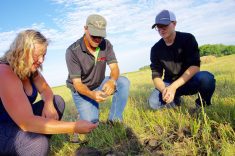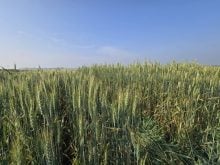Glacier FarmMedia — Fruit and vegetables make up a lot of the food that Canadians throw away.
Of all household food items that end up in the trash, vegetables represent 30 per cent of total food waste by weight, while fruits come in at 15 per cent, according to anti-food waste website LoveFoodHateWaste.ca.
The site, operated by the National Zero Waste Council, claims that Canadians throw out 1.3 million apples, 2.6 million potatoes and 1.3 million tomatoes every day.
Read Also

Seeding Indigenous agricultural prosperity
National Circle for Indigenous Agriculture and Food says Indigenous agricultural success needs strong relationships.
Lovemore Malunga, an Agriculture and Agri-Food Canada scientist in Winnipeg, is working on a way to reduce those numbers, and part of the answer might lie inside oat groats.
“We’re working with the fruit growers to see if we can use oat starch as a coating … to coat the fruits,” said Malunga.
His work explores the functional and nutritional properties of pulse crops and cereals, and includes a project that creates a kind of biofilm based on oat starch. The hope is that the coating could extend the shelf life of produce.
Edible starch, like that found in oats, is a moisture barrier, forming an almost waxy coating that keeps fruit from rotting. Instead of fruit lasting one week, “it could potentially last two weeks,” Malunga said.
It could be sprayed on, although baths in which fruit is washed in the oat starch formulation is another option.
The concept is appealing, since oat starch is safe for human consumption and could replace plastic used to preserve fruit and vegetables. However, it is a long way from commercialization.
AAFC scientists in Nova Scotia have also been testing the preservative powers of the oat starch formulation on fruit and berries.
“We are waiting to hear, good or bad,” Malunga said.
“Theoretically, it should work … This is the first formulation. There is still room for improvement.”
Malunga’s research is one project among many that seek new ways to preserve produce and cut food waste — a topic that garners attention for both food security and environmental reasons.
Last year, a group of Spanish food scientists published a literature review on edible coatings.
“The need for food waste reduction, the consumers’ interest in incorporating more fresh products in their diet and the awareness of society about the environment are … why edible coatings are receiving so much interest from the scientific community,” they wrote in a paper published at mdpi.com.
Some companies are already selling coatings that protect fruit and vegetables.
Apeel from California has developed a coating derived from plant oils. The company says it acts like another layer of peel to the fruit or vegetable.
“Our plant-based protection slows water loss and oxidation, the primary causes of spoilage,” says its website.
Greenhouse growers in Ontario started experimenting with Apeel’s technology in 2022 to replace the plastic wrap typically covering English cucumbers.
Dino Di Laudo of Topline Farms in Leamington, Ont., told CTV News that it was testing the coating and shipping Apeel-treated cucumbers to 12 grocery stores in Toronto.
“I’m hopeful that within two or three years that this will be the norm for cucumbers,” he told the news channel at the time.
















